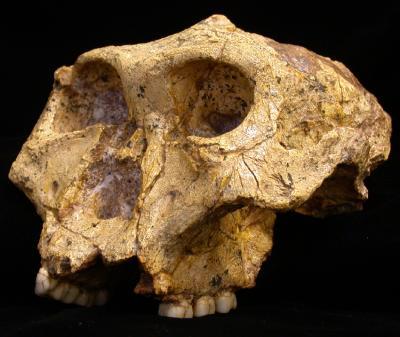So far, ranging and residence patterns amongst early hominins have been indirectly inferred from morphology, stone tool sourcing, comparison to living primates and phylogenetic models. An international team of researchers including Sandi Copeland, Vaughan Grimes and Michael Richards of the Max Planck Institute for Evolutionary Anthropology in Leipzig/Germany have now investigated landscape use in Australopithecus africanus (with fossils from sites dating between 2.8-2.0 million years ago) and Paranthropus robustus (with fossils from sites dating between 1.9-1.4 million years ago) from the Sterkfontein and Swartkrans cave sites in South Africa using strontium isotope analysis. This method helps identify the geological substrate on which an animal lived during tooth mineralization. (Nature, June 2nd, 2011)
The researchers show that a high proportion of small, but not large, hominin teeth had non-local strontium isotope compositions. Given the relatively high levels of sexual dimorphism in early hominins, the smaller teeth probably represent females, indicating that females were more likely than males to disperse from their natal (i.e. where they were born) groups. This is similar to the dispersal pattern found in chimpanzees, bonobos, and many human groups, but dissimilar to that of most gorillas and other primates.
Established paleontological and archaeological techniques provide little tangible evidence for how early hominins used and moved across landscapes. For example, home range size has been estimated based on a rough correlation with body mass, and models of early hominin dispersal have relied on behaviors common among hominoids and presumed to be present in a common ancestor. "However, the highly uncertain nature of such reconstructions limits our understanding of early hominin ecology, biology, social structure, and evolution", says Sandi Copeland of the Max Planck Institute for Evolutionary Anthropology.
Copeland and colleagues have now used a geochemical proxy, strontium isotope analysis of tooth enamel, to investigate early hominin landscape use. Strontium is ingested and incorporated in trace quantities into mammalian teeth. First, the researchers determined strontium isotopes in plant specimens that were collected within a 50 km radius of the Sterkfontein and Swartkrans caves in order to establish the background of biologically available strontium across the region. They then sampled a series of hominin tooth crowns by employing a relatively new method for measuring strontium isotopes in teeth that is called laser ablation multicollector inductively coupled plasma mass spectrometry (LA-MC-ICP-MS). This method is almost non-destructive as it leaves only tiny traces on the enamel surface. The researchers found that although there is no significant difference between the proportion of non-locals in P. robustus (36 %) and A. africanus (25 %), there are significant differences between subsets of hominins defined by tooth size.

This is a skull of a Paranthropus robustus from Swartkrans Cave in South Africa.
(Photo Credit: Darryl de Ruiter)
"The strontium isotope data suggest differences in landscape use between males and females", says Sandi Copeland and explains: "Because strontium was incorporated into the teeth before adulthood, when the hominins were probably travelling with their mothers, the data are unlikely to reflect differences in foraging areas between adult males and adult females. Rather, the strontium isotopes probably indicate that females preferentially moved away from residential groups".
The hominins' female but not male dispersal pattern is similar to the one found in chimpanzees, bonobos, and many human groups, but dissimilar to that of most gorillas and other primates. This suggests that early hominin social structure was not like that of gorillas in which one or few males dominate groups of females.
The small proportion of non-local large hominins could indicate that male australopiths had small home ranges, which would be surprising given that the evolution of bipedalism is commonly attributed to the need to move over large distances. The results could also imply that male australopiths preferred the types of resources found on dolomite landscapes. This study was the first to apply this method to early fossil hominins, and lays the groundwork for future studies of other fossil species, including Australopithecus and Paranthropus in East Africa, and later hominins belonging to our genus Homo.
Source: Max-Planck-Gesellschaft